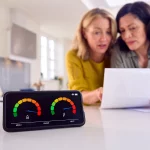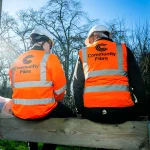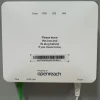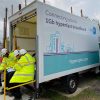Study Finds No Mobile Operator in Powys Surpasses 50% for Good Coverage

Mobile UK network analyst firm Streetwave has published the first results from their work with the Growing Mid Wales (GMW) programme, which uses bin lorries to map local network (4G, 5G etc.) coverage and broadband performance. Overall, none of the mobile operators provided “Good Coverage” across more than 50% of Powys’ road network, but EE does come top (49%).
The use of bin collections to map mobile coverage and data performance is one that has only recently started to become popular (here, here and here). In this setup, refuse collection vehicles are installed with four off-the-shelf Smartphones using software from Streetwave on top, which run continuous network tests (once every 20 metres in rural areas and 5m in urban areas) as the vehicles go about their routes.
The data this produces is typically much more accurate than the flaky estimates of mobile coverage that are so often produced by network operators and Ofcom, which is because bin lorries need to go down almost every single road in order to conduct their collections and do so on a weekly basis. Suffice to say that this makes them a uniquely useful resource for conducting this sort of study.
Advertisement
Streetwave itself typically deems an operator to have delivered “Good Coverage” where their network provides users with mobile broadband performance of at least 5Mbps download, 2Mbps upload, and below 40ms (milliseconds) latency. These are said to be speeds where “most ordinary use cases” including internet browsing, video streaming or conference calls can be performed.
The average level of “Good Coverage” across the operators in Powys was found to be just 40%. But Streetwave also identified “large areas affected by total not-spots” in the region. Across 20.4% of Powys, there was not a single operator who could deliver download speeds above 5Mbps. Likewise, across 35.9% of Powys, no operators could deliver upload speeds above 2Mbps.
Levels of Good Mobile Coverage in Powys (May 2024)
| Mobile Operator | ‘Good Coverage’ in Powys |
| 1 – EE (BT) | 49% |
| 2 – Vodafone | 46% |
| 3 – O2 (Virgin Media) | 39% |
| 4 – Three UK | 26% |
In addition, the survey also identified areas that could deliver so-called “Essential Coverage“, which reflects locations able to deliver performance of at least 1Mbps download, 0.5Mbps upload speeds and below 100ms latency. The figures are naturally a bit higher here, although trying to use the modern internet at such speeds can be excruciating.
Advertisement
Levels of Essential Mobile Coverage in Powys (May 2024)
| Mobile Operator | ‘Essential Coverage’ in Powys |
| 1 – EE (BT) | 69% |
| 2 – Vodafone | 66% |
| 3 – O2 (Virgin Media) | 57% |
| 4 – Three UK | 53% |
The results from this project will now be used by GMW to identify digitally excluded communities across Mid Wales and to potentially deliver targeted connectivity interventions to improve the situation. Results from Ceredigion will also be published soon.
Streetwave has so far conducted similar bin lorry-based surveys in 30 local authority areas during 2024 (many of these are ongoing) and they’re now in discussions with another 50 councils. In an ideal world, all of this data would need to be made available to consumers via a visual interactive map in order for it to be truly helpful, although a basic address checker is anticipated.
Mark is a professional technology writer, IT consultant and computer engineer from Dorset (England), he also founded ISPreview in 1999 and enjoys analysing the latest telecoms and broadband developments. Find me on X (Twitter), Mastodon, Facebook, BlueSky, Threads.net and Linkedin.
« Devon and Somerset UK Re-opens 4G Mobile Boost Scheme






















































Using the bin lorries is a sensible approach. But my personal experience in my network-forsaken part of Wales is that it isn’t even as good as shown.
A major part of the reason is that so often the signal drops off within feet. Even with two networks on my phone (main SIM and an eSIM from another network), I often lose all usable signal. So any movement often drops connection – even on foot.
And bin lorries miss an awful lot of the coast! Like actual beaches. (Not much coast in Powys, I know!) Am glad my phone allows satellite access in a real emergency.
I’ve also noticed that very often both networks I have disappear in the same places. If both were separately rated at 50%, there combined rating would likely be no more than a few percent higher, something like 54%. (Obviously that is a guess!)
What an excellent study, hope they will put it to good use, and hope the operators make some capacity improvements as a result. This has huge implications for H&S risk assessments for mobile field staff, such as care and social workers – ie this data will determine the best network to keep staff connected and safe.
Such a clever idea and the data is incredibly useful.
Agree this is a great means to obtain real-world signal data. Would love to see this approach taken down in the nooks and crannies of deepest, darkest Cornwall to the same effect. I’m a rural postie, and wonder if the red van fleet could also be employed to continously survey. I have both an EE sim, plus a Scancom multi-network sim to attempt to provide address look-ups, but the fact remains that there are a great many spots of no signal from any network.
Similar to the coverage in most of Devon, however very few areas are total not spots, foreign visitors actually get excellent service because they can roam across all 4 networks. OFCOM really needs to get a grip, the SRN scheme was supposed to resolve this, we don’t need lots of brand new cell sites, we need the S in SRN to start happening.
Hang on.
We are just checking if the 80 Million people in England care about the mobile coverage that the 132000 people in Powys may or may not be receiving.
Survey says no.
Three’s 3G only areas must be the reason they are on 26% good coverage. Unless it means combined generational coverage but even then Three only operate 3G on B1 which cannot be good for geographical coverage.
Hard to believe that no operator exceeds 5MB download!